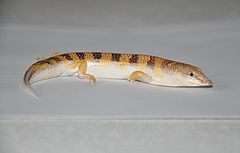Scincinae – podrodzina jaszczurek z rodziny scynkowatych (Scincidae).
Szybkie fakty Domena, Królestwo ...
| Scincinae |
| * Scincoides Oppel, 1811[1] |
|

Przedstawiciel podrodziny – scynk aptekarski (Scincus scincus) |
| Systematyka
|
| Domena
|
eukarionty |
| Królestwo
|
zwierzęta |
| Typ |
strunowce |
| Podtyp |
kręgowce |
| Gromada |
zauropsydy |
| Rząd |
łuskonośne |
| Infrarząd |
Scincomorpha |
| Rodzina |
scynkowate |
| Podrodzina |
Scincinae |
| Typ nomenklatoryczny |
|
Scincus Garsault, 1764 |
| Synonimy |
|
- Scincoides[uwaga 1] Oppel, 1825[1]
- Scincidia[uwaga 2] Rafinesque, 1815[2]
- Sincidae Gray, 1825[3]
- Scincina — Gray, 1845[4]
- Ophiomoridae[uwaga 3] Gray, 1845[5]
- Opheomorinae[uwaga 4] Cope, 1864[6]
- Anelytropidae[uwaga 5] Cope, 1864[7]
- Feyliniidae[uwaga 6] Cope, 1875[8]
- Feyliniidae[uwaga 7] Camp, 1923[9]
- Scincinae — Mittleman, 1952[10]
- Chalcidinae[uwaga 8] Mittleman, 1952[10]
- Feylininae[uwaga 9] Greer, 1970[11]
- Paracontiini[uwaga 10] Welch, 1982[12]
- Eumecinae[uwaga 11] Griffith, Ngo & Murphy, 2000[13]
- Culexlineatascinciina[uwaga 12] Hoser, 2015[14]
- Starkeyscinciini[uwaga 13] Hoser, 2015[15]
- Starkeyscinciina Hoser, 2015[15]
- Parabrachymeliini[uwaga 14] Hoser, 2015[16]
- Adelynhoserscinciini[uwaga 15] Hoser, 2015[17]
- Eumeciini[uwaga 16] Hoser, 2015[18]
- Adelynhoserscinciina Hoser, 2015[19]
- Funkiskinkiina[uwaga 17] Hoser, 2015[20]
- Asiascinciina[uwaga 18] Hoser, 2015[21]
- Janetaescinciini[uwaga 19] Hoser, 2015[22]
- Gongylomorphiini[uwaga 20] Hoser, 2015[23]
- Gongylomorphiina Hoser, 2015[24]
- Chalcidiina[uwaga 21] Hoser, 2015[25]
- Sloppyscinciini[uwaga 22] Hoser, 2015[25]
- Sloppyscinciina Hoser, 2015[26]
- Paracontiina[uwaga 23] Hoser, 2015[27]
- Hakariina[uwaga 24] Hoser, 2015[28]
- Sirenoscinciina[uwaga 25] Hoser, 2015[28]
- Scelotiina[uwaga 26] Hoser, 2015[29]
- Feyliniini[uwaga 9] Hoser, 2015[30]
- Nessiini[uwaga 27] Hoser, 2015[30]
|
|
| Rodzaje |
|
34 rodzaje – zobacz opis w tekście |
|
|
|
|
|
Zamknij
Podrodzina obejmuje gatunki występujące w Afryce, Eurazji i Ameryce Północnej[31][32].
Do podrodziny należą następujące rodzaje[31]:
- Amphiglossus Duméril & Bibron, 1839
- Barkudia Annandale, 1917
- Brachymeles Duméril & Bibron, 1839
- Brachyseps Erens, Miralles, Glaw, Chatrou & Vences, 2017
- Chalcides Laurenti, 1768
- Chalcidoseps Boulenger, 1887 – jedynym przedstawicielem jest Chalcidoseps thwaitesi (Günther, 1872)
- Eumeces Wiegmann, 1834
- Eurylepis Blyth, 1854
- Feylinia Gray, 1845
- Flexiseps Erens, Miralles, Glaw, Chatrou & Vences, 2017
- Gongylomorphus Fitzinger, 1843
- Grandidierina Mocquard, 1894
- Hakaria Steindachner, 1899 – jedynym przedstawicielem jest Hakaria simonyi (Steindachner, 1899)
- Janetaescincus Greer, 1970
- Jarujinia Chan-ard, Mekchai & Cota, 2011 – jedynym przedstawicielem jest Jarujinia bipedalis Chan-ard, Mekchai & Cota, 2011
- Madascincus Brygoo, 1981
- Melanoseps Boulenger, 1887
- Mesoscincus Griffith, Ngo & Murphy, 2000
- Nessia Gray, 1839
- Ophiomorus Duméril & Bibron, 1839
- Pamelaescincus Greer, 1970 – jedynym przedstawicielem jest Pamelaescincus gardineri (Boulenger, 1909)
- Paracontias Mocquard, 1894
- Plestiodon Duméril & Bibron, 1839
- Proscelotes de Witte, 1943
- Pseudoacontias Bocage, 1889
- Pygomeles Grandidier, 1867
- Scelotes Fitzinger, 1826
- Scincopus Peters, 1864 – jedynym przedstawicielem jest Scincopus fasciatus (Peters, 1864)
- Scincus Garsault, 1764
- Scolecoseps Loveridge, 1920
- Sepsina Bocage, 1866
- Sepsophis Beddome, 1870 – jedynym przedstawicielem jest Sepsophis punctatus Beddome, 1870
- Typhlacontias Bocage, 1873
- Voeltzkowia Boettger, 1893
Pisownia oryginalna nazwy rodziny.
Typ nomenklatoryczny: Scincus Daudin, 1802
Typ nomenklatoryczny: Ophiomorus Duméril & Bibron, 1839.
Niepoprawna późniejsza pisownia Ophiomoridae Gray, 1845.
Typ nomenklatoryczny: Anelytrops Duméril, 1856 (= Feylinia Gray, 1845; nazwa zastępcza dla Typhlinidae Gray, 1845.
Typ nomenklatoryczny: Feylinia Gray, 1845; nazwa zastępcza dla Anelytropidae Cope, 1864.
Nazwa zastępcza dla Anelytropidae Cope, 1864; młodszy homonim Feyliniidae Cope, 1875. Typ nomenklatoryczny: Chalcides Laurenti, 1768.
Typ nomenklatoryczny: Feylinia Gray, 1845; nie Feyliniidae Cope, 1875 i Feyliniidae Camp, 1923.
Typ nomenklatoryczny: Paracontias Mocquard, 1894.
Typ nomenklatoryczny: Eumeces — Griffith, Ngo & Murphy, 2000 (= Plestiodon Duméril & Bibron, 1839.
Typ nomenklatoryczny: Culexlineatascincus Hoser, 2015 (= Mesoscincus Griffith, Ngo & Murphy, 2000).
Typ nomenklatoryczny: Starkeyscincus Hoser, 2015 (= Ophiomorus Duméril & Bibron, 1839).
Typ nomenklatoryczny: Parabrachymeles Hoser, 2015 (= Brachymeles Duméril & Bibron, 1839).
Typ nomenklatoryczny: Adelynhoserscincus Hoser, 2015 (= Plestiodon Duméril & Bibron, 1839).
Typ nomenklatoryczny: Eumeces Wiegmann, 1834; nie Eumecae Fitzinger, 1843 i Eumecini Griffith, Ngo & Murphy, 2000.
Typ nomenklatoryczny: Funkiskinkus Hoser, 2015 (= Plestiodon Duméril & Bibron, 1839.
Typ nomenklatoryczny: Asiascincus Hoser, 2015 (= Plestiodon Duméril & Bibron, 1839).
Typ nomenklatoryczny: Janetaescincus Greer, 1970.
Typ nomenklatoryczny: Gongylomorphus Fitzinger, 1843.
Typ nomenklatoryczny: Chalcides Laurenti, 1768; nie Chalcidinae Mittleman, 1952.
Typ nomenklatoryczny: Sloppyscincus Hoser, 2015.
Typ nomenklatoryczny: Paracontias Mocquard, 1894; młodszy homonim Paracontiini Welch, 1982.
Typ nomenklatoryczny: Hakaria Steindachner, 1899.
Typ nomenklatoryczny: Sirenoscincus Sakata & Hikida, 2003 (= Voeltzkowia Boettger, 1893.
Typ nomenklatoryczny: Scelotes Fitzinger, 1826.
Typ nomenklatoryczny: Nessia Gray, 1845.
K.R.G. Welch. Herpetology of the Old World 2. Preliminary comments on the classification of skinks (family Scincidae) with specific reference to those genera found in Africa, Europe and southwest Asia. „Herptile”. 7 (4), s. 25, 1982. (ang.).
- J.E. Gray: Catalogue of the Specimens of lizards in the collection of the British museum. London: The Trustees, 1845, s. i–xxviii; 1–289. (ang.).
- E.D. Cope. On the characters of the higher groups of Reptilia Squamata—and especially of the Diploglossa. „Proceedings of the Academy of Natural Sciences of Philadelphia”. 16, s. 224–231, 1864. (ang.).
- R.T. Hoser. A revision of the genus level taxonomy of the Acontinae and Scincinae, with the creation of new genera, subgenera, tribes and subtribes. „Australasian Journal of Herpetology”. 28, s. 1–64, 2015. (ang.).
- R.T. Hoser. A revision of the genus level taxonomy of the Acontinae and Scincinae, with the creation of new genera, subgenera, tribes and subtribes. „Australasian Journal of Herpetology”. 29, s. 65–128, 2015. (ang.).
Identyfikatory zewnętrzne
(
takson):
